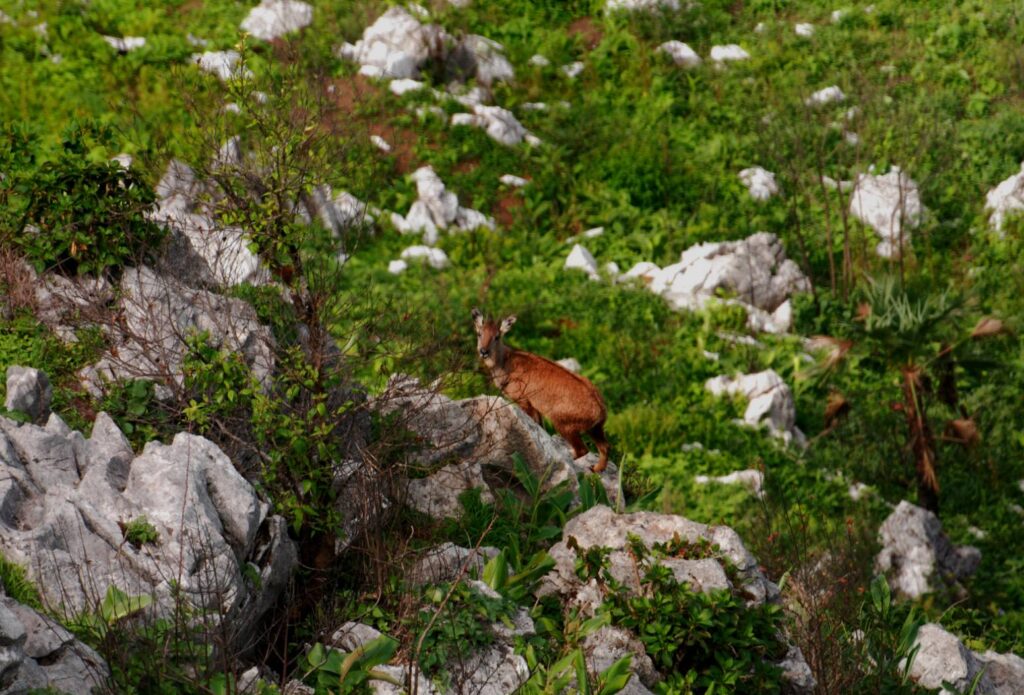The country’s latest Biosphere Reserve listed by Unesco, Doi Chiang Dao, has been declared closed by the DNP to prevent further damage caused by forest fires resulting from human activities including wildlife hunting and conflict in the area. The closure is made indefinite
The National Parks, Wildlife and Plant Conservation Department has decided to close Chiang Dao Wildlife Sanctuary indefinitely until it can control the fires in the area as well as activities deemed to lead to forest fires including wildlife hunting and disordered homestays. The DNP’s chief, Athapol Charoenshunsa, signed a new order on Friday, which took effect immediately.
The department reasoned that among protected forests in Chiang Mai this year, Doi Chiang Dao has been hit by hotspots the most, 197 so far and the trend is likely to increase. The latest fire incident has occurred at Doi Nang close to the main mountain of Doi Chiang Dao.
According to some news sources in the area, the mountain has been burned for the third time already. The first and second rounds of the forest burnings were involved with reckless burning of cornfields, which then spread into the forests. The third round of the fire is different and could be intentional to draw the officers’ attention away from the tasks at hand, including regular patrols.
Doi Chiang Dao itself has also been burned by forest fires this year. Wildlife hunting and conflict over homestays and resorts are reported to play a role in the forest fires at Doi Chiang Dao as well. This year, they are not yet caused by such conflict yet as there have been no fires on the side where those resorts and homestays are located, but some forest officers are already concerned that the indefinite closure would trigger dissatisfaction and the fire on that side.
When Doi Chaing Dao and its adjacent areas get burned, it’s hard for the forest officers to douse the fires as the mountains are steep. The department therefore has decided to close it for access and use to mitigate the damage done by the forest fires in the middle of the season and to allow the mountains’ fragile ecology to recover.
The department can also use this moment to address the issues there and solve them. Limited access and use of the forests there will be allowed for forest dwellers allowed for modest living under the wildlife protection and conservation law’s Section 121. A new joint panel to look into law enforcement, forest use, and forest rehabilitation will be appointed to address these challenges accordingly.
“The department apologies for any inconvenience we may have caused, but the closure is needed to protect Doi Chiang Dao so that we can review and revise our management there,” the department noted in the order.
Also read: Doi Luang Chiang Dao under threat of “wild” fires

Background: Getting to know Doi Chiang Dao
In late 2021, the International Co-ordinating Council of the Man and the Biosphere (MAB) Programme under UNESCO held its 33rd session online from Nigeria’s Abuja and decided to designate Thailand’s “Doi Chiang Dao” as its new Biosphere Reserve along with some other 22 sites around the world. These sites including Doi Chiang Dao have been added to the World Network of Biosphere Reserves, which has 714 biosphere reserves in 129 countries, including 21 transboundary sites.
Apart from World Heritage Sites, UNESCO also promotes this Man and Biosphere Programme, under which sites demonstrating the good linkage between the conservation of biodiversity and sustainable use of humans will be designated as Biosphere Reserves. As explained by UNESCO, they are “learning areas for sustainable development under diverse ecological, social, and economic contexts, touching the lives of more than 250 million people”.
“They are sites for testing interdisciplinary approaches to understanding and managing changes and interactions between social and ecological systems, including conflict prevention and management of biodiversity. They are places that provide local solutions to global challenges,” notes UNESCO.
Normally, Biosphere Reserves are nominated by national governments and designated under the intergovernmental MAB Programme by the Director-General of UNESCO following the decisions of the MAB International Coordinating Council (MAB ICC) if meeting the criteria.
Doi Chiang Dao, or locally known as Doi Luang Chiang Dao which is the main mountain of Chiang Dao Wildlife Sanctuary, had been nominated by Thailand three or four years before becoming the Biosphere Reserve. It is the country’s fifth after Ranong Biosphere Reserve, which was designated in 1997. The other three previously designated reserves are Sakaerat Environmental Research Station (1976), Hauy Tak Teak Biosphere Reserve (1977), and Mae Sa-Kog Ma Biosphere Reserve (1977).


l Valuable resources on Doi Luang Chiang Dao including rare gorals. Credit: DNP
Located in Chiang Dao district of Chiang Mai Province, it is the only region in Thailand covered with sub-alpine vegetation found in the Himalayas and down through the southern part of China, according to the International Advisory Committee for Biosphere Reserves (IACBR).
The core areas, which account for 41.92% of the total area (proposed at over 536,900 rai), have been strictly protected as the Chiang Dao Wildlife Sanctuary for more than 40 years. The north-western tip of the core area, which is not surrounded by a buffer zone or transition area, borders the Pha Daeng National Park. It’s home to rare and preserved animals including gorals and serows, plus over 670 species of wild animals.
The buffer zones consist mostly of secondary forest and reforested areas, belonging to the Chiang Dao Wildlife Sanctuary, the Chiang Dao National Reserve Forest, and areas designated for agricultural land reform. These areas are targeted for ecologically friendly economic activities, the committee noted.
One of the two transition areas is located at the eastern end of the site; the other is surrounded by the western section of the buffer zones. Both areas are administrated by regional and local authorities.
Following its limestone formations, rains have infiltrated through and created a number of caves, and the largest and most important of these is Chiang Dao Cave. The cave, however, houses a Buddhist temple in the Lanna style and is a place where the legend of Chao Luang Chiang Dao originated, thus being revered as a sacred place.
Meanwhile, numerous underground creeks converge to form the Ping River to the east of the proposed site, and there is a traditional gravity-based irrigation system called Maung Fai, which is also a notable feature of the area. Such numerous examples of these have been maintained by local practices and knowledge over almost 800 years, the committee noted. The site is also an eco-tourism destination with natural and cultural activities in the Chiang Dao Cave and the Yang Pu Toh Hot Spring, as well as birdwatching along the Mae Kong River.
The committee said it acknowledged that the conceptual framework of the biosphere reserve management is consistent with the existing plans of the districts, sub-districts and the Sanctuary and took note of a policy of payment for ecosystem services (PES) operating in the southern buffer zone. A forest village of Ban Pang Ma-O sells branded forest-shade coffee, the packaging of which informs buyers that their purchase helps maintain the forest, which provides water-regulating services for the Ping River.
“The proposed site presents a good model for visitor impact management, which can be as a reference for other fragile ecosystem destinations. Previously, the summit of Doi Luang Chiang Dao and the opium fields were subject to high visitor numbers. At present, only nature research visits are permitted on the summit and are regulated by strict controls and impact mitigation measures. The summit is also well managed with zero waste,” the committee pointed out.
It, therefore, recommended that the site be approved, the recommendation which was endorsed by the MAB ICC in mid-September, 2021.
Indie • in-depth online news agency
to “bridge the gap” and “connect the dots” with critical and constructive minds on development and environmental policies in Thailand and the Mekong region; to deliver meaningful messages and create the big picture critical to public understanding and decision-making, thus truly being the public’s critical voice


